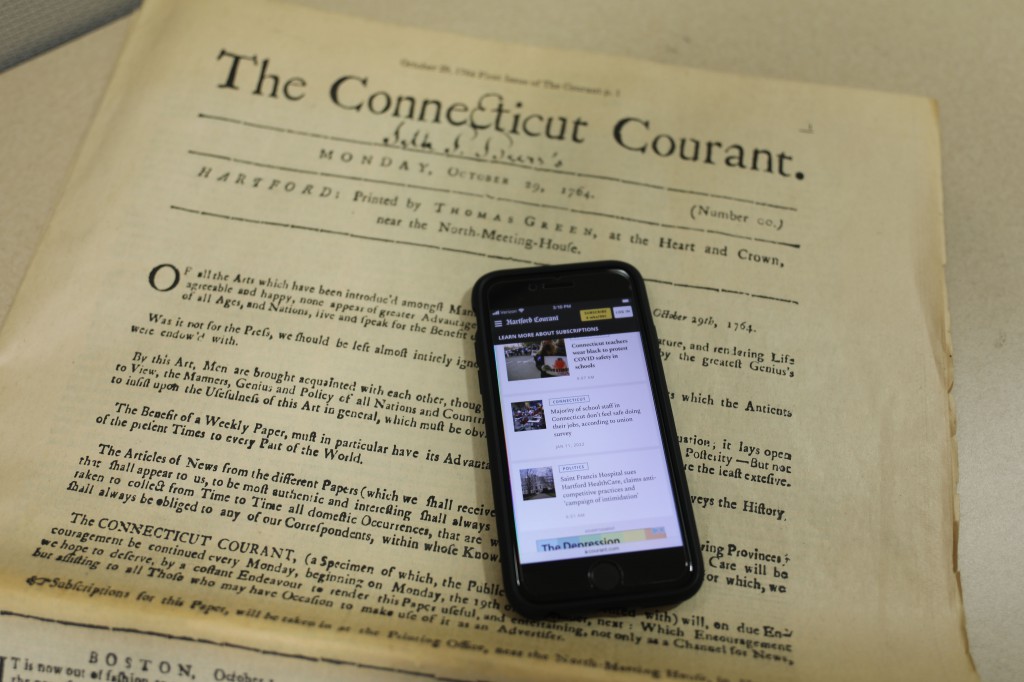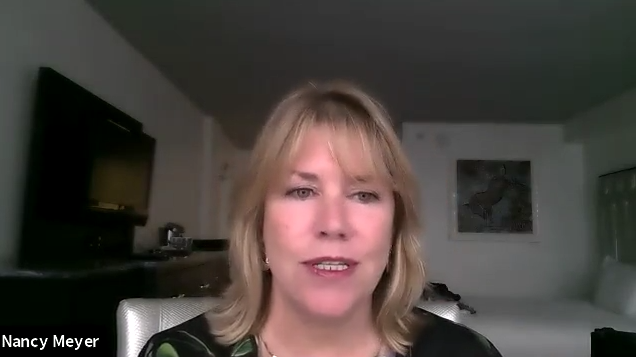The transition to the digital age at the nation’s oldest continuously published newspaper is the subject of a new series of oral histories produced by the Hartford History Center at the Hartford Public Library.
The Hartford Courant: From Print to Digital Oral History Project includes 19 Zoom interviews with current and former staffers at The Courant that were conducted in the Spring and Summer of 2021 and sheds light on the adjustments, challenges and successes of the Hartford Courant during the last years of the 20th century and early decades of the 21st century as it entered the digital age and transitioned from being a primarily print media outlet.
“The Hartford History Center holds the Hartford Courant print edition bound volumes spanning the centuries; this resource maintains its value and relevance even in the electronic age,” said Brenda Miller, Hartford Public Library’s executive director of culture and communications. “The history of The Courant is a Hartford story, with deep roots in this community, and we prize our role as the repository for such an extensive print collection. The Print to Digital Oral History Project carries the story forward for an ever-evolving medium.”
The interviewees include four former publishers, as well as a mix of editors, reporters and photographers and web specialists. All interviews are available on the Connecticut Digital Archive.
“These oral histories of the people involved in the Courant’s transition to the digital age offer a new, unvarnished behind the scenes look at that transition,” said David S. Barrett, former editor and vice president of The Courant. Barrett, chair of the Hartford Public Library Board of Directors, assisted in the planning and implementation of the project and conducted several of the interviews.
“We pull the curtain back to illuminate the tumultuous years at The Courant as it built its digital presence,” he said. “I would like to thank Hartford Public Library for giving me the opportunity to work on this important project. And thank you as well to the folks we interviewed, who gave so generously of their time and spoke so candidly about their careers at The Courant. These interviews will allow us to chronicle a period of Courant history through firsthand storytelling.”
Barrett, who worked at The Courant for 27 years, including three as the paper’s top editor, said working on the project was a valuable learning experience as his departure from The Courant came at the very beginning of the transition to a digital platform and he had little firsthand experience with the transformation.
In addition to Barrett, interviews for the project were also conducted by Lauren Schafer, a student in the University of Connecticut’s Encore!Connecticut program that assists corporate and public sector professionals as they transition to opportunities in the nonprofit sector.
While the advent of the internet age allowed newspapers like The Courant to share their stories with a global audience, it deeply cut into revenue from classified advertising as people turned to free services like Craigslist to list job opportunities, apartments for rent or cars for sale. And the rise of online shopping and subsequent decline of brick-and-mortar retail impacted advertising revenue as well.
“One of the things I suspected that was confirmed to a degree, and this was not unique to the Hartford Courant, was The Courant took too long to understand the digital world was a money-making opportunity, an opportunity to make money in a new way,” Barrett said. “The Courant offered its content [online] at the beginning for free, as did most newspapers in the country.”
With their news available online for free, increased competition in a crowded media environment where newspapers were one of just many sources of news and newsrooms shrinking due to annual declines in advertising revenue, print newspaper circulation sank at a rapid pace. According to figures from Pew Research, total weekday circulation of U.S. daily newspapers was 55.8 million in 2000, 44.4 million in 2010 and just 24.3 million by 2020.
Weekday circulation at The Courant was about 216,000 in 2000 and about 135,000 in 2010, according to reports published in the newspaper those years. The Alliance for Audited Media reported The Courant had a weekday print circulation of less than 52,000 in the fourth quarter of 2019.
Newspapers across the country have struggled mightily to replace lost revenue from print subscriptions with new revenue from online ads and digital subscriptions.
“We initially gave our news to someplace like a Yahoo or a Google for free because it allowed more people to see it,” Nancy Meyer, who worked at The Courant from 2006-2014, including two years as publisher, said in one of the interviews. “We relied probably on page views versus expanding our audience and ensuring that that audience paid for that content. … If we could go back and do something a little different, maybe we shouldn’t have given it away for free. Maybe we should have set a target at that point earlier, but we were experimenting. The fact is little was known at that point. Today I’d say we might’ve gone back and done that differently.”
While the transition to the digital age may have hurt newspapers’ bottom lines, it undoubtedly provided new opportunities for journalists and an enhanced user experience with the advent of photo galleries, videos, data visualizations, interactive maps and timelines and other multimedia features to accompany reporting, as well as new ways for reporters to engage with their audience. And metrics let reporters and editors get a real-time view of what stories were popular with readers and helped to shape news coverage.
“I think that we can meet information needs in a way that maybe we couldn’t before,” said Megan Merrigan, who as The Courant’s director of audience engagement heads up the organization’s digital efforts. “We could reach more people, we could hear from more people, we could include more voices in our coverage. I think all of that is valuable and positive things that have come from digital distribution of the paper. … There’s a lot of really smart people across the country working in this space that are doing really amazing things. We’re all at a reckoning and figuring out how we can be sustainable, how we can do what we love doing, how we can fulfill this mission, but I’m really inspired by all the smart people working to solve that problem. That gives me hope and that makes me optimistic.”
Barrett said other interesting discussions that came up in the interviews included the increased pressure in the digital age to publish stories quickly to the web – and the challenges that brought – as well as the impact of social media and how it has contributed to the distrust of journalism.
“We learn from history, and so to chronicle the fits and starts of The Courant’s transition to the digital age through interviews with a variety of people who got in on the ground floor in the late 1990s and early 2000s, that really provides valuable perspective on that change,” he said.
Editor’s note: Hartford Public Library Communications Manager Russell Blair was a digital producer, reporter and editor at The Courant from 2012-2021.


